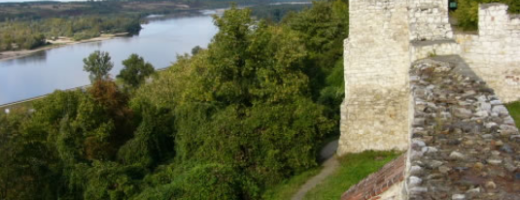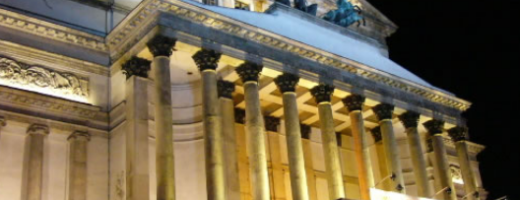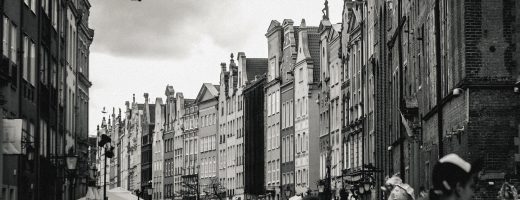A scholar who specializes in Polish history offers a convenient summary of Poland, Warsaw and the erratic history of homosexual life in this often-invaded and defiant country. Also see: Gay Poland Stories Gay Poland News & Reports 2001 to present Gay Poland Photo Galleries This report is taken mostly from: An Encyclopedia of Gay, Lesbian,
There is no law against gays. Homosexual sex was generally legalised in 1932. The age of consent is equal for both homosexual and heterosexual partners. Homosexual prostitution was legalized in 1969. Homosexuals are not banned from military service. Homosexuality was deleted from the list of diseases in 1991. A survey from 2005 found 89% of the population stating that they consider homosexuality an “unnatural” activity. Additionally, only half believe homosexuality should be tolerated. 74% and 89% of Poles respectively are opposed to same-sex marriage and adoption by gay couples. Former parliament member Robert Biedroń, current mayor of Slupsk city, was the president of the Polish Campaign Against Homophobia society. In 2008 the Rainbow flag flew from the British Embassy in Warsaw during the Warsaw’s Pride festival. The march marked the final day of ‘Equality Days,’ a week-long festival with the slogan ‘Live, Love, Be’. 2,000 people took part in this year’s parade. Warsaw police were out in force to prevent attacks by extreme right sympathizers, although the parade passed without major incident. Bans on Polish Pride festivals in 2004 and 2005 were found to be unlawful by Polish courts and the European Court of Human Rights. Today LGBT citizens are entrenched in the national psyche.

- GlobalGayz
- »
- Europe
- »
- Poland
Gay Poland: A Visit to an Historic and Conservative Country
A drive around this beautiful friendly country reveals fertile farms, soaring cathedrals and castles, a tormented past and a boisterous and fairly prosperous present. Scattered pockets of gay culture and life, in the big cities, are energetic but still muted and surrounded by much homophobia.
Poland’s Gays Awake Gradually to a New Era
Gay life is gaining steam slowly in very Catholic and very heterosexist Poland. With the weakening of the Catholic Church’s influence, the increased role of the Internet and Poland’s entry into the European Union (with it’s pro-gay laws), a place in the sun is being urged by an increasingly bold LGBT community. But the battlelines are clearly drawn as loud protests disrupted gay pride events in May and June 2004.
A guest author, a correspondent for the Chicago Tribune, offers a modern re-appraisal of gay life in Warsaw. From the grim and rusted Soviet repression a new era of openness and courage spurs homosexuality to dare to speak its name–despite strong ‘spiritual violence’ from conservative and religious activists.
Poland – Kazmierz Dolny
(City in photos 1-13?) (Photos 14-30 in the environs of Kazimierz Dolny) Kazimierz Dolny (photos 31-50) is a small town in eastern Poland, on the eastern bank of the Vistula River in Pulawy County, Lublin Province. It is a considerable tourist attraction as one of the most beautifully situated little towns in Poland. It enjoyed
Poland – Zakopane
Zakopane is a town in southern Poland with some 30,000 inhabitants. The town, a place of Góral culture and informally known as "the winter capital of Poland," lies at the foot of the Tatra Mountains, the only alpine mountain range in the Carpathian Mountains. It is an appealing tourist town with its forests and streams
Poland – Wroclaw City & Antonin Region
In the Antonin area (south central) is the famous Radziwill Hunting Palace (photos 1-17) of the famous 19th century Polish aristocratic Radziwill family but now well known as the place where Frederick Chopin visited (1827 and 1829) and performed. In this beautiful yet rustic 4-story wood ‘palace’ today are held concerts in the composer’s honor.
Poland – Wieliczka: Salt Mines
The Wieliczka Salt Mine, located in the town of Wieliczka, is within Poland’s Kraków metropolitan area. It had been until 2007 in continuous operation, producing table salt, since the 13th century. It was one of the world’s oldest operating salt mines. The mine reaches down to a depth of 327 meters (1000 feet) and is
Poland – Poznan: City and Region
Poznan is a city in west-central Poland with about 570,000 inhabitants. Located on the Warta River, it is one of the oldest cities in Poland, making it an important historical centre and a vibrant centre of trade, industry, and education. Poznan´ is Poland’s fifth largest city and fourth biggest industrial centre. It is also the
Poland – North Coast
Poland has a long coastline on the Baltic Sea with numerous resorts and towns with beautiful scenery.
Poland – Lancut Castle / Zamosc Town
Lancut Castle in the town of Lancut. The town in south-eastern Poland, with about 20,000 inhabitants. In the middle of the town is Lancut Castle, a grand aristocratic palace residence, last owned until 1944 by the Potocki family. It was first built in the years 1629-1641 and reconstructed many times since. The palace is currently
Poland – Krakow City (2)
Kraków is one of the largest and oldest cities in Poland, with a population of 756,336 in 2007. It has traditionally been one of the leading centres of Polish scientific, cultural and artistic life. As the former national capital with a history encompassing more than a thousand years, the city remains the spiritual heart of
Poland – Krakow City (1)
Kraków is one of the largest and oldest cities in Poland, with a population of 756,336 in 2007. It has traditionally been one of the leading centres of Polish scientific, cultural and artistic life. As the former national capital with a history encompassing more than a thousand years, the city remains the spiritual heart of
Poland – Kalisz: Friends
Daily life and working class people in Poland.
Poland – Krakow: Gay Venues
There is no central LGBT organization or venue, no publication, no gay café or restaurant in Krakow. There’s not much of a ‘community’ here. “There is not even a cruising area now–it was busted by the police last year,” my host lamented. But scattered around town are low-key watering holes where like-minded folks gather for
Poland – Kolobrzeg
Kolobrzeg is a city in Middle Pomerania in north-western Poland with some 55,000 inhabitants. The city was founded in the 9th century and was pounded in World War II and has been fully restored. Today it’s a popular tourist destination for both Poles and the Germans. It provides a unique combination of a seaside resort,
Poland – Auschwitz
Auschwitz was the largest of Nazi Germany’s concentration camps. Its remains are located in Poland approximately 50 kilometers west of Kraków and 286 kilometers south from Warsaw. The camp took its name from the nearby town of Oswiecim (Auschwitz in German). Birkenau, the German translation of Brzezinka, refers to the many birch trees surrounding the
Poland – Kalisz: City (2)
Kalisz is a city in central Poland with about 120,000 inhabitants. The city is an important regional industrial and commercial centre, with many notable factories, the Calisia piano factory among them. The city is also a centre for traditional folk art. Kalisz is now considered to be the oldest town of Poland, because it was
Poland – Kalisz: City (1)
Kalisz is a city in central Poland with about 120,000 inhabitants. The city is an important regional industrial and commercial centre, with many notable factories, the Calisia piano factory among them. The city is also a centre for traditional folk art. Kalisz is now considered to be the oldest town of Poland, because it was
Poland – Gdansk
Gdansk – is the city at the center of the fourth-largest metropolitan area in Poland. It is Poland’s principal seaport as well as the capital of the Pomeranian Voivodeship. Historically an important seaport and shipbuilding center, Gdansk was a member of the historic Hanseatic League. The city was the birthplace of the Solidarity movement which,
Poland – Ciechanow/Torun
Ciechanow is a town in north-central Poland with 47,900 inhabitants (2002). Before World War II, it was home to a large Jewish community. During the war many Polish Jews and resistance fighters were executed by the Germans in the castle. Torun is a city in northern Poland, on the Vistula River, with population over 207,190
Poland – Warsaw Gay Venues
A drive around this beautiful friendly country reveals fertile farms, soaring cathedrals and castles, a tormented past and a boisterous and fairly prosperous present. Scattered pockets of gay culture and life, in the big cities, are energetic but still muted and surrounded by much homophobia. Recent political leaders have opposed gay festivals and parades but
Poland – Warsaw City (2)
Warsaw’s population as of 2007 was estimated at 1,706,624, with a metropolitan area of approximately 3,350,000. It is the capital of Poland. Warsaw’s mixture of architectural styles reflects the turbulent history of the city and country. During World War II, Warsaw was razed to the ground by bombing raids and Nazi destruction. After liberation mass
Poland – Warsaw City (1)
Warsaw’s population as of 2007 was estimated at 1,706,624, with a metropolitan area of approximately 3,350,000. It is the capital of Poland. Warsaw’s mixture of architectural styles reflects the turbulent history of the city and country. During World War II, Warsaw was razed to the ground by bombing raids and Nazi destruction. After liberation mass
Poland – Treblinka
Treblinka II was a German extermination camp in occupied Poland during World War II. Around 850,000 people – more than 99.5 percent of them Jews, but also other victims (among them 2,000 Romani people) – were killed there between July 1942 and October 1943; the camp was closed after a revolt during which a few
Poland – Birkenau
Auschwitz-Birkenau was the largest of Nazi Germany’s concentration camps. The camp took its name from the nearby town of Oswiecim (Auschwitz in German). Birkenau, the German translation of Brzezinka, refers to the many birch trees surrounding the complex. The Auschwitz-Birkenau State Museum estimates the death toll at 1.1 million, about 90 percent of whom were
Poland – Zalipie
Zalipie is a village in southern Poland sprinkled with color that blossoms all year as people have painted their buildings with bright and decorative patterns and hues. Some of the photos speak for themselves.



